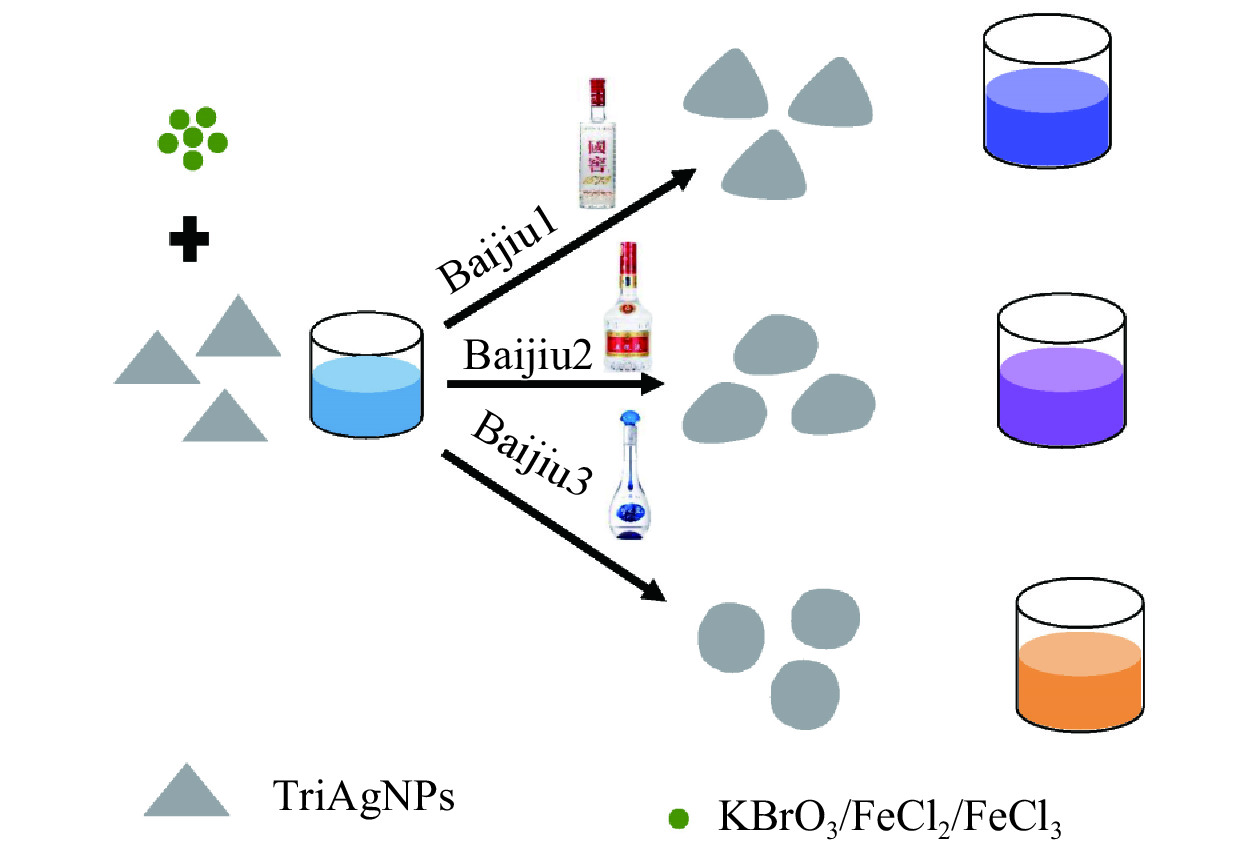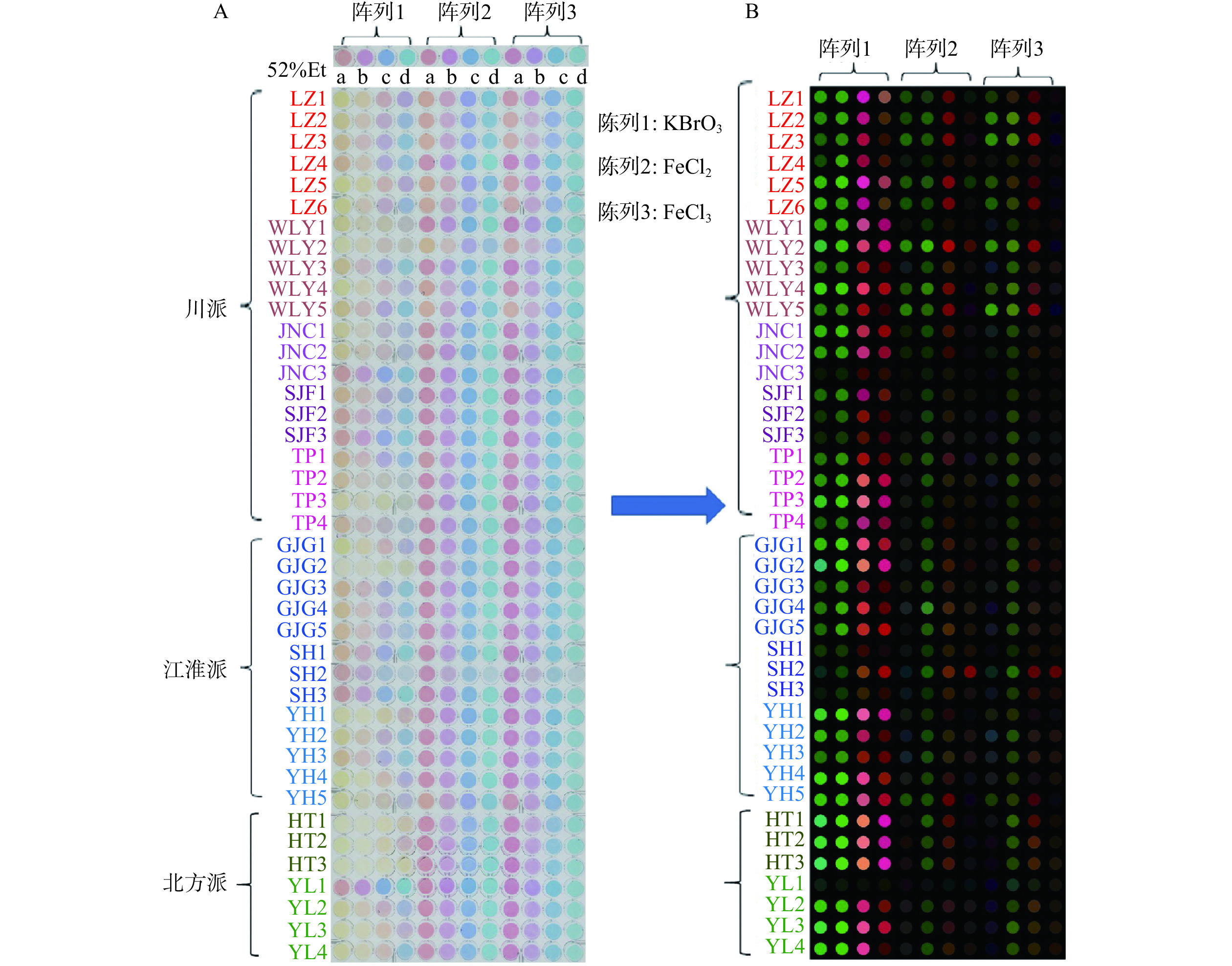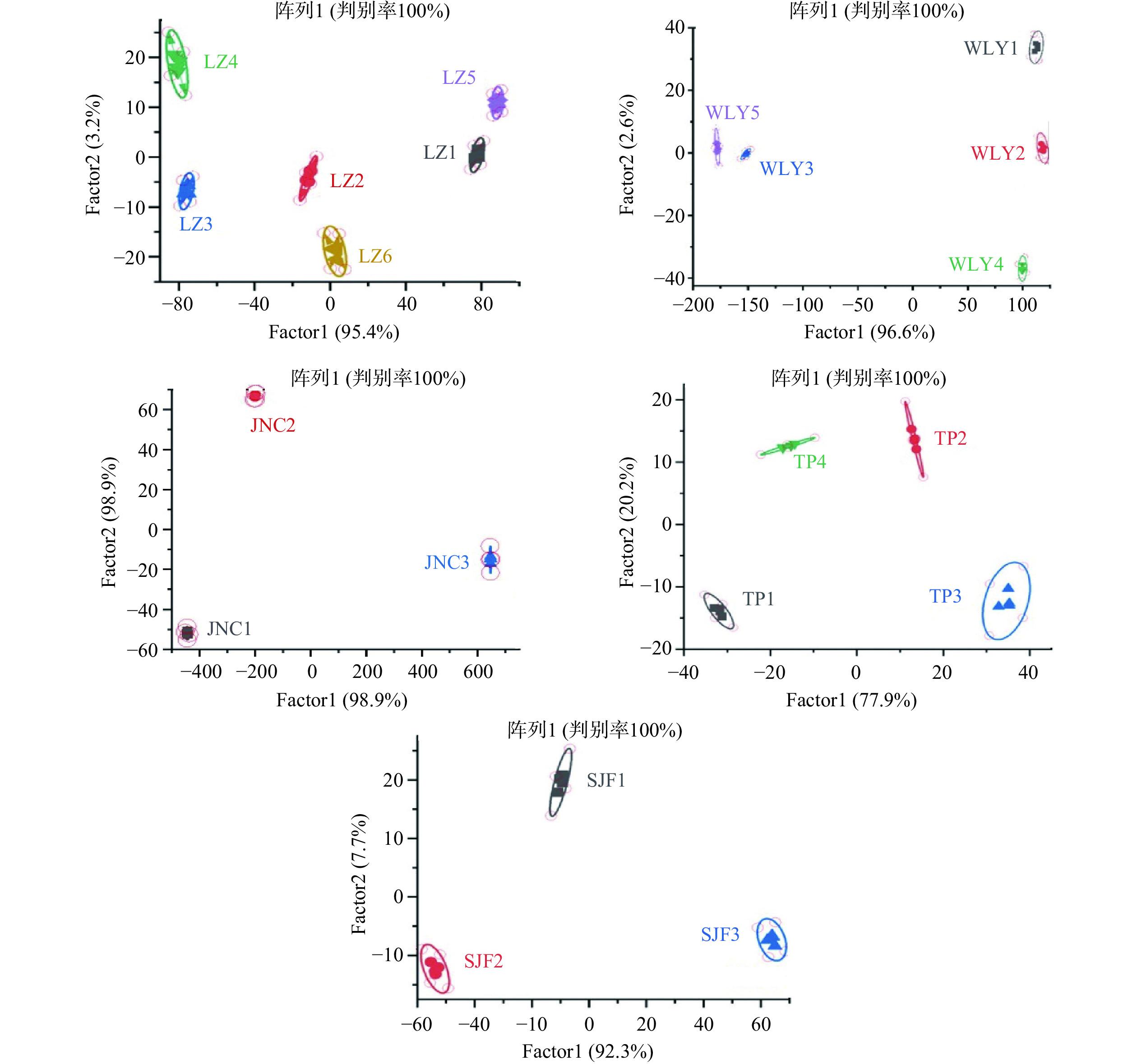Discrimination of Strong Aroma-type Baijiu of Different Origins Based on Ag Nanoprism Etching Mechanism
-
摘要: 区分不同产地白酒对于产品质量控制和原产地保护具有重要意义。本研究以四种不同形貌大小的银纳米三角片(Ag nanoprism,AgNPRs)作为传感材料,两种金属离子和一种氧化阴离子作为氧化蚀刻剂,基于AgNPRs蚀刻机制构建了一种4×3传感阵列,将该阵列对四川、江淮和北方三大产地共41款代表性浓香型白酒样品进行比色响应,所获得的比色信号值通过线性判别分析(linear discriminant analysis,LDA)进行判别分析,并进一步选取了部分未知样品对判别模型进行了外部验证。比色响应机制研究结果表明,白酒样品对AgNPRs的蚀刻效应起促进作用,这可能与白酒中含有不同的有机酸有关。对不同产地样品的区分结果显示,单一阵列对不同产地样品的区分效果相对较低,三种阵列组合后的区分效果明显提高,对41个样品的产地判别率可达99%,对15个未知浓香型酒样的产地判别率可达98%。采用组合阵列对四川产地5种品牌21个样品和江淮产地3种品牌13个样品判别率分别可达99%和100%,采用单一阵列对四川各厂家不同等级产品的判别率均可达100%。本研究采用的纳米比色传感方法简便快速,不仅可用于产品鉴别和防伪,也可辅助用于生产过程质量监控,为白酒质量智能化监控奠定研究基础。Abstract: Discriminating strong aroma-type Baijiu (SAB) of different origins was significant for product quality control and origin protection. In this study, a 4×3 sensor array was constructed based on the Ag nanoprism (AgNPR) etching mechanism, in which four AgNPRs varying in shape and size were used as sensing materials, and two metal ions and one oxide anion were used as oxidation etchants. With this array, colorimetric reaction was conducted on 41 representative SAB samples from Sichuan, Jianghuai and North China. The obtained colorimetric signal values were subjected to linear discriminant analysis (LDA). Furthermore, some samples of unknown origin were selected to perform external validation on the discrimination model. Based on the results of colorimetric reaction mechanism, the samples could promote the etching effect of AgNPRs, which might be related to various organic acids contained in Baijiu. Sample discrimination showed that single array produced a comparatively low effect on samples of different origins. The combination of three arrays significantly improved the discrimination effect, whose rate of origin discrimination was up to 99% for 41 samples, and was up to 98% for 15 unknown samples. With combined array, the discriminant rates of 21 samples from 5 brands in Sichuan and 13 samples from 3 brands in Jianghuai could reach 99% and 100%, respectively, while all the discriminant rates could reach 100% for different grades of products from various manufacturers in Sichuan with single array. Being simple and fast, the nanocolorimetric sensing method adopted in this study is not only applicable to product identification and anti-counterfeiting, but also be auxiliarily used for quality control in production process, laying a research foundation for intelligent quality monitoring of Baijiu.
-
浓香型白酒也称为泸型酒,是中国最受欢迎的白酒香型之一,市场占有量近70%[1]。浓香型白酒按酿造原料划分为两类,一类是单粮型,以泸州老窖为代表,一类为多粮型,以五粮液为代表。浓香型白酒产品种类丰富,产地分布较广,其中四川、安徽、江苏是浓香型白酒最主要的产区,尤以四川产量最大,优质酒品最多[2]。不同产地的浓香型白酒由于酿造原料、发酵工艺、地理环境、勾调技术等方面的差异,其风味特点存在多样性,也使得产品品质参差不齐,这就给浓香型白酒的品质控制带来很大挑战,也给产品市场提供了掺杂掺假的可能。因此,浓香型白酒的产地区分和鉴别对于产品质量监管和消费者权益保护具有重要意义。
近十年来陆续有报道采用不同方法和技术手段结合化学计量学方法用于不同种类白酒的区分和鉴别,包括色谱质谱技术[3−4],如顶空固相微萃取-质谱(HS-SPME-MS)[5−6]、气相离子迁移谱(GC-IMS)[7]、气相色谱-质谱(GC-MS)[8−10]、全二维气相色谱飞行时间质谱(GC×GC-TOF-MS)[11];光谱技术,如近红外、中红外光谱技术(NIR)[12−14]结合主成分分析、偏最小二乘判别等数据分析方法。色质谱和光谱法存在复杂费时或灵敏性较低及数据处理复杂等问题,而光学电子鼻和电子舌由于其简便快速灵敏及易实现便携化的优点近年来用于各种酒类的鉴别研究。如Suslick团队以不同染料分子作为色敏材料对不同品牌蒸馏酒的比色传感识别[15−16],Bunz团队以荧光分子作为传感材料用于白葡萄酒[17]、白兰地[18]、威士忌[19]等酒精饮料的区分,国内也有学者基于电化学法和荧光传感法对不同白酒区分进行了研究[20−21]。这类比色和荧光传感方法大大简化了操作程序,提高了灵敏度,然而其便捷性、稳定性和选择性还相对较低等问题尚未得到良好解决。
局域表面等离子共振(LSPR)是基于贵金属纳米颗粒受到入射光激发引起表面电子共振的光学性质,LSPR吸收对纳米粒子大小、形貌、表面修饰及周围介质高度敏感[22−23],本课题组前期已报道基于金纳米粒子形貌和表面修饰引起LSPR性质变化的机制用于不同香型和不同等级白酒的区分和识别研究[24−25]。银纳米三角片(AgNPRs)由于边缘/尖端的高反应性,容易被氧化剂等蚀刻为圆形,导致SPR出现蓝移[26−28]。基于该机制,Li等[29]报道了不同金属离子通过调节AgNPRs蚀刻变化用于区分不同种类的白酒。这种具有边缘尖端的AgNPRs不仅会因蚀刻剂不同而引起形貌不同程度的变化,而且本身不同的形貌大小也具有不同的LSPR性质,所以蚀刻剂的不同和AgNPRs形貌大小的差别均可作为引起差异化响应信号的阵列构建策略,基于蚀刻剂和AgNPRs形貌变化差异的传感阵列拓展策略并未用于品类繁多的浓香型白酒的产地鉴别研究。
本研究中通过合成四种不同形貌大小的AgNPRs作为传感元件,以两种不同价态的金属离子和氧化性阴离子(Fe2+、Fe3+、BrO3¯)作为蚀刻剂构建4×3比色传感阵列,以不同产地浓香型白酒作为研究对象,通过蚀刻剂与白酒微量成分之间化学作用引起蚀刻环境的变化造成银纳米粒形貌的不同,产生不同白酒样品各自不同的颜色变化,从而进一步用于区分不同产地浓香型白酒。
1. 材料与方法
1.1 材料与仪器
浓香型白酒样品 共采集41个,包括四川产地21个样品,江淮产地13个样品,以及北方产地7个样品,其中泸州老窖酒样由泸州老窖股份有限公司提供,其它白酒样品购自白酒专卖店,具体样品信息见表1~表3;硝酸银(AgNO3)、硼氢化钠(NaBH4)、柠檬酸三钠、溴酸钾(KBrO3)、氯化铁(FeCl3)、氯化亚铁(FeCl2) 分析纯,国药集团化学试剂有限公司;聚苯乙烯磺酸钠(PSS)MW 70000 分析纯,上海麦克林生化科技有限公司;L-抗坏血酸(AA) 分析纯,萨恩化学技术(上海)有限公司。
表 1 四川产地浓香型白酒样品信息Table 1. Detailed information on SAB samples of Sichuan origin编号 产品 酒精度(%vol) 厂家 产地 LZ1 窖龄酒30年 52 泸州老窖 四川泸州 LZ2 窖龄酒60年 52 泸州老窖 四川泸州 LZ3 窖龄酒90年 52 泸州老窖 四川泸州 LZ4 特曲 52 泸州老窖 四川泸州 LZ5 国窖1573-1 52 泸州老窖 四川泸州 LZ6 国窖1573-2 52 泸州老窖 四川泸州 WLY1 五粮液-1 52 五粮液 四川宜宾 WLY2 五粮液-2 52 五粮液 四川宜宾 WLY3 A级佳宾 52 五粮液 四川宜宾 WLY4 五粮精酿 45 五粮液 四川宜宾 WLY5 五粮特曲 52 五粮液 四川宜宾 JNC1 金剑南 K6 52 剑南春 四川绵竹 JNC2 金剑南24K 52 剑南春 四川绵竹 JNC3 剑南春 52 剑南春 四川绵竹 TP1 沱牌舍得 52 沱牌 四川遂宁 TP2 沱牌曲酒 52 沱牌 四川遂宁 TP3 生态酒 45 沱牌 四川遂宁 TP4 沱牌特曲 52 沱牌 四川成都 SJF1 水井坊 52 水井坊 四川成都 SJF2 井台 52 水井坊 四川成都 SJF3 水井尚品 52 水井坊 四川成都 表 3 北方产地浓香型白酒样品信息Table 3. Detailed information on SAB samples of Northern origin编号 产品名 酒精度(%vol) 厂家 产地 YL1 生态小窖 46 伊力特 新疆伊犁 YL2 伊力珍 46 伊力特 新疆伊犁 YL3 伊力王 50 伊力特 新疆伊犁 YL4 伊力特曲 50 伊力特 新疆伊犁 HT1 河套老窖 42 河套酒业 内蒙古巴彦淖尔 HT2 河套王 39 河套酒业 内蒙古巴彦淖尔 HT3 河套王5星 36 河套酒业 内蒙古巴彦淖尔 表 2 江淮产地浓香型白酒样品信息Table 2. Detailed information on SAB samples of Jianghuai origin编号 产品名 酒精度(%vol) 厂家 产地 GJG1 年份原浆幸福版 50 古井贡 安徽亳州 GJG2 年份原浆-古5 50 古井贡 安徽亳州 GJG3 年份原浆-古16 50 古井贡 安徽亳州 GJG4 古井贡-V6 50 古井贡 安徽亳州 GJG5 古井贡-V9 40.6 古井贡 安徽亳州 SH1 国字宋河 46 宋河酒业 河南周口 SH2 秘藏3号 50 宋河酒业 河南周口 SH3 秘藏5号 50 宋河酒业 河南周口 YH1 微分子 38 洋河酒厂 江苏宿迁 YH2 梦之蓝M3 52 洋河酒厂 江苏宿迁 YH3 梦之蓝M6 52 洋河酒厂 江苏宿迁 YH4 天之蓝 52 洋河酒厂 江苏宿迁 YH5 海之蓝 52 洋河酒厂 江苏宿迁 U3900紫外可见光光谱仪 日本HITACHI公司;JEM-2100F高分辨率透射电子显微镜日本 日本JEOL公司;D750数码相机 日本尼康公司。
1.2 实验方法
1.2.1 AgNPRs材料制备
银纳米三角片(AgNPRs)根据Aherne等[30]报道的种子液介导的两步还原合成方法进行制备。
银种子液制备:柠檬酸三钠溶液(5 mL,2.5 mmol/L)作为封盖剂、聚苯乙烯磺酸钠(PSS)(0.25 mL,500 mg/L)作为表面活性剂、和新配制的还原剂NaBH4溶液(0.3 mL,10 mmol/L)混合于50 mL样品瓶中,然后在磁力搅拌条件下以2 mL/min的速率逐滴加入AgNO3溶液(5 mL,0.5 mmol/L)后形成银纳米种子液。其中,PSS在实现纳米片尺寸和形状的均匀性方面起着关键作用。
生长液制备:抗坏血酸溶液(75 μL,10 mmol/L)作为弱还原剂与5 mL去离子水和不同量(600、400、200、90 µL)的银种子液混合,然后以1 mL/min速率逐滴加入AgNO3溶液(3 mL,0.5 mmol/L)后形成银纳米三角片溶液。种子液的添加量决定着所生长的银纳米片的形貌大小。随着种子液添加量的增加,所形成的银纳米片溶液的表面等离子共振吸收峰逐渐红移,伴随着不同的颜色变化。银纳米片合成后,加入柠檬酸三钠溶液(0.5 mL,25 mmol/L)以对银纳米溶液起进一步的稳定作用。
1.2.2 AgNPRs传感阵列制备
AgNPRs比色传感阵列由四种不同形貌的AgNPRs在不同蚀刻剂存在条件下(如KBrO3、FeCl2、FeCl3)组成。传感组件加样顺序为AgNPRs(50 μL)、水(50 μL)、KBrO3(10 μL,5 mmol/L)/FeCl2(10 μL,2.5 mmol/L)/FeCl3(10 μL,5 mmol/L)、酒样(10 μL),以52%vol乙醇作为对照。图像在反应10 min后通过数码相机获取。所有的比色实验均在96孔板中进行。
1.2.3 图像采集方法
图像采集方法参考文献[24]报道的方法。反应10 min后用配制EFS 18-135 mm变焦镜头的EOS 750D相机进行拍照。96孔板放置在15瓦LED平板灯上,96孔板周边用黑布进行遮光,整个拍照过程均在暗室条件下进行。相机设置参数为曝光速度为1/125 s,光圈设置为f/11,感光度为ISO 400。
1.3 数据处理
RGB数据提取:采用Adobe Photoshop CC2019提取图片每个反应孔中心点的R、G、B值, RGB值与对照之间的差值(ΔRGB)作为比色响应值,每组实验重复3次,三次实验的ΔRGB及其均值用于统计学数据分析,ΔRGB均值放大4倍生成的色差图用于比色可视化展示,欧氏距离(EDs)=√ΔR2+ΔG2+ΔB2,用于表示AgNPRs比色反应颜色变化值。
统计学数据分析方法:基于ΔRGB的初始数据矩阵在Excel 2019中进行整理。主成分分析(PCA)采用MATLAB 2018内置的函数进行数据处理。线性判别(LDA)采用SYSTAT 13.2进行数据运算,所有的变量采用完全模式,且公差设置为0.001,计算每个样品数据到组质心的马氏距离,根据最短马氏距离用于各样品数据的分类,采用刀切法交叉验证计算判别准确率。PCA和LDA数据处理结果采用内置有置信椭圆插件的Origin 2021进行图形绘制。
2. 结果与分析
2.1 AgNPRs传感阵列构建原则
AgNPRs边缘/尖端具有良好的折射率、灵敏度以及局域电场增强,赋予其独特的LSPR性质,这种性质随其形貌大小的变化而不同。由于其边缘或尖端容易受到氧化剂的氧化而导致AgNPRs发生蚀刻从而引起形貌的变化,这一蚀刻过程很容易受到反应环境的影响。白酒是一种复杂基质,含有非常丰富的化合物,不同种类的白酒所含化合物的种类和含量存在差异。当AgNPRs蚀刻反应处于白酒微环境条件下时,会由于不同白酒之间的差异导致其蚀刻程度的不同,引起不同的LSPR效应,从而伴随有不同的颜色变化。当AgNPRs形貌大小不同时,由蚀刻效应引起LSPR性质的变化也会不同。基于此,本研究合成了四种不同形貌大小的AgNPRs,选用了两种不同价态的金属离子(Fe2+、Fe3+)以及一种氧化性阴离子(BrO3¯)作为蚀刻剂构建一种传感组件为4×3的比色传感阵列,比色响应机制如图1所示。
2.2 AgNPRs材料表征
合成不同形貌均匀大小的AgNPRs是构建比色传感阵列的关键策略之一,本研究合成了四种大小不一的AgNPRs。通过TEM表征,显示了四种不同大小三角形状的银纳米片,即AgNPRs-a、AgNPRs-b、AgNPRs-c、AgNPRs-d,银纳米片的大小以三角边长计,平均长度分别为55.0、38.7、30.6、22.7 nm。紫外可见光光谱(UV-vis)显示了其因形貌大小不同从而具有不同的等离子吸收峰,典型的特征峰波长分别为655、590、528、499 nm(图2)。
2.3 AgNPRs传感阵列反应体系优化
为获得比色传感阵列较高的比色信号RGB值变化,本研究对氧化反应条件进行了优化。由于构建传感阵列的基本原则是基于蚀刻效应,所以蚀刻反应试剂的浓度优化至关重要。图3所示,随着蚀刻剂KBrO3/FeCl2/FeCl3添加量的增加,欧氏距离所反映的颜色变化值呈现逐渐增加的趋势,这是由于AgNPRs形貌发生变化所致。为了探究白酒样品对这种蚀刻作用的影响,选取了每种蚀刻剂颜色发生明显变化前的浓度来探究白酒对该蚀刻剂蚀刻效果的影响。据此,在三个反应体系(均为120 µL)中三种蚀刻剂的添加量分别为10 μL 10 mmol/L KBrO3、10 μL 5 mmol/L FeCl2和10 μL 10 mmol/L FeCl3。
2.4 反应机理验证
不同形貌大小的AgNPRs其蚀刻机理相同,为进一步验证白酒对这种传感机制的影响,以四种形貌大小适中的AgNPRs-b为例,以LZ-6为代表样品,进行了UV-vis和比色实验。如图4所示,当加入三种蚀刻剂和52%乙醇之后,AgNPRs-b吸收峰没有明显变化。当加入LZ-6后,波峰明显降低,且发生一定程度的蓝移,说明在反应体系中三角银的尖端逐渐变钝,同时颜色从紫红色变为黄色或粉色。不同的是,在FeCl3体系中320 nm左右的吸收峰明显增高,这可能是由于加入Fe3+生成不同的氧化产物引起。白酒中含有多种有机酸,因此白酒溶液为酸性体系,大多数白酒处于pH3.5~4.5范围内。银纳米三角片蚀刻属于氧化还原反应过程,在氧化性离子存在的情况下,纳米银逐渐被氧化为银离子,当处于酸性条件时会促进这一氧化反应的进行。因此,白酒中最为重要的呈味物质有机酸对纳米银的蚀刻过程起着关键作用。另外,白酒是各种风味物质不断发生相互作用的平衡体系,含量较多的酯类和醇类的种类和含量的不同也会在一定程度上影响银蚀刻效应。
为进一步直观地证明在白酒样品存在条件下蚀刻剂对AgNPRs-b形貌的影响,以LZ-3和LZ-5为例,通过TEM对加入两种不同白酒样品后AgNPRs-b形貌的变化进行观察。如图5所示,在Fe2+蚀刻体系中加入不同白酒样品AgNPRs-b形貌发生了不同程度的变化,加入LZ-3后AgNPRs-b形貌变化不太明显,但加入LZ-5后AgNPRs-b的尖端逐渐被钝化为圆形,证实了在同一反应体系中不同白酒样品促进了不同程度的蚀刻效应。
2.5 不同产地浓香型白酒识别
为了验证基于AgNPRs传感阵列用于白酒的识别性能,本研究以不同浓香型白酒样品作为研究对象进行比色响应测试。由于传感元件的构建是基于氧化反应引起的银纳米蚀刻机制,因此,氧化性的不同所诱导的蚀刻效应也会不同。银较易被氧化,很多具有氧化性的离子均可以氧化纳米银为银离子,本研究中选取了常见三种具有不同氧化性的离子(BrO3−>Fe3+>Fe2+)作为蚀刻剂用于构建比色传感阵列。另外,同一氧化剂对不同形貌大小的AgNPRs产生的蚀刻效应也会存在明显差异。在本研究中选取了四种不同形貌大小的AgNPRs-a、b、c、d为传感材料,KBrO3、FeCl2、FeCl3作为蚀刻剂,构建4×3比色传感阵列,分别作为阵列1、2、3。该阵列进一步与41种来自不同产地、不同品牌、不同等级的浓香型白酒进行比色响应,图6A显示了3种阵列在加入不同浓香型白酒样品之后的比色响应图,图6B则是白酒样品与52%vol乙醇对照之间的∆RGB差值形成的可视化色差图。从色差图可以看到,尽管绝大部分浓香型白酒具有同样的酒精度,然而却表现出每种白酒样品各自特定的色差模式,说明色差模式之间的差异由各白酒样品含有不同种类和含量的微量成分差异引起,甚至对于同一品牌之间的样品也会由于这种差异导致不一样的色差模式。其中,阵列1由于KBrO3较强的氧化性产生了明显的颜色变化。Fe3+和Fe2+的氧化性与BrO3−相比相对较弱,产生了较弱的比色响应,但由于二者氧化性之间的差异,阵列2和阵列3的比色响应之间仍显示了一定的差异性。这种基于蚀刻剂和纳米银形貌差异构建的比色传感阵列显示了用于识别不同种类白酒的潜力。
首先采用无监督的PCA对三种比色传感阵列色差模式进行分析,如图7A所示,PCA结果显示三大产区的样品较为分散,没有明显的聚类趋势,但可以看到对于每个样品的4个重复数据均可以聚一起,说明每个样品的重复性较好。进一步采用了有监督的LDA方法进行交叉判别分析,单个阵列显示了较低的区分性能,阵列1、阵列2和阵列3对三大产地酒样的判别率分别为76%、84%、82%,将三个阵列组合后可以显著提高其区分性能,如图7B显示,三大产区样品能够明显聚到一起,交叉判别准确率可达到99%,仅有川派的两个样品数据被错判到了江淮派。
进一步对四川和江淮两大主要浓香型白酒产区不同品牌酒样进行了LDA分析。首先采用单一阵列对两大产区进行了分析,结果显示阵列1、阵列2和阵列3对川派不同品牌浓香酒样的交叉判别率分别为94%、83%、79%,尽管阵列2和阵列3显示了相对低的判别率,但当二者组合后,区分性能明显增加,判别可达98%。当三种阵列进行组合后,交叉判别率可达99%。同样,阵列1、阵列2和阵列3对江淮派不同品牌浓香酒样的交叉判别率分别为90%、90%、96%,尽管阵列1信号最为明显,但阵列3的数据显示了对于江淮派样品之间更大的差异,当阵列两两组合和三种组合后,对于江淮派样品的判别率均为100%。图8显示了三种阵列组合对川派和江淮派样品的LDA分析图。另外,选取了15个浓香型白酒未知类别的样品共60个样品数据进行外部验证,根据最短马氏距离将未知类别的样品分配到训练模型确定的相应组别中,对于三大产地的预测分类准确率可达98%,表4显示了不同阵列对于不同类别样品的交叉判别率以及预测准确率。
表 4 Jackknifed分类判别和未知样品验证Table 4. Jackknifed classification matrix and unknown sample identification obtained from LDA样品 Jackknifed分类判别 未知样品判定 样品数 正确分类数 准确率 样品数 正确分类数 准确率 三大区 164 162 99 60 59 98 川派 84 83 99 36 35 97 江淮派 52 52 100 16 16 100 北方派 28 28 100 8 8 100 同一厂家也存在不同等级品质的产品,因此对于不同等级白酒的区分有利于企业对于产品的质量监控。如图9所示,采用单个阵列1即可对10个厂家各自不同等级的浓香型白酒进行明显区分,Jackknifed分类判别率可达100%,进一步验证了该传感策略对于具有相似风味特征的不同等级产品良好的区分性能。
3. 结论
本研究基于AgNPRs蚀刻机制,采用四种不同形貌大小的AgNPRs在三种不同氧化剂条件下构建比色传感阵列,对不同产地不同品牌以及不同等级的41种浓香型白酒样品进行了比色响应,研究证实白酒样品对这种比色响应起到一定促进作用。采用LDA模式判别方法组合阵列对三大产地浓香型白酒样品的区分判别率可达到99%,对川派和江淮派不同厂家浓香型白酒的判别率分别可达99%和100%,即便同一厂家不同等级产品采用单一阵列即可实现100%的判别率。这种基于纳米蚀刻机制对不同种类白酒进行区分的方法策略不仅适用于浓香型白酒,也可用于其它各种香型白酒。在今后的研究中可通过修饰或调控纳米粒子的形貌进一步提高其精准度,为白酒行业实现质量智能化和模块化控制提供研究基础和方法借鉴。
-
表 1 四川产地浓香型白酒样品信息
Table 1 Detailed information on SAB samples of Sichuan origin
编号 产品 酒精度(%vol) 厂家 产地 LZ1 窖龄酒30年 52 泸州老窖 四川泸州 LZ2 窖龄酒60年 52 泸州老窖 四川泸州 LZ3 窖龄酒90年 52 泸州老窖 四川泸州 LZ4 特曲 52 泸州老窖 四川泸州 LZ5 国窖1573-1 52 泸州老窖 四川泸州 LZ6 国窖1573-2 52 泸州老窖 四川泸州 WLY1 五粮液-1 52 五粮液 四川宜宾 WLY2 五粮液-2 52 五粮液 四川宜宾 WLY3 A级佳宾 52 五粮液 四川宜宾 WLY4 五粮精酿 45 五粮液 四川宜宾 WLY5 五粮特曲 52 五粮液 四川宜宾 JNC1 金剑南 K6 52 剑南春 四川绵竹 JNC2 金剑南24K 52 剑南春 四川绵竹 JNC3 剑南春 52 剑南春 四川绵竹 TP1 沱牌舍得 52 沱牌 四川遂宁 TP2 沱牌曲酒 52 沱牌 四川遂宁 TP3 生态酒 45 沱牌 四川遂宁 TP4 沱牌特曲 52 沱牌 四川成都 SJF1 水井坊 52 水井坊 四川成都 SJF2 井台 52 水井坊 四川成都 SJF3 水井尚品 52 水井坊 四川成都 表 3 北方产地浓香型白酒样品信息
Table 3 Detailed information on SAB samples of Northern origin
编号 产品名 酒精度(%vol) 厂家 产地 YL1 生态小窖 46 伊力特 新疆伊犁 YL2 伊力珍 46 伊力特 新疆伊犁 YL3 伊力王 50 伊力特 新疆伊犁 YL4 伊力特曲 50 伊力特 新疆伊犁 HT1 河套老窖 42 河套酒业 内蒙古巴彦淖尔 HT2 河套王 39 河套酒业 内蒙古巴彦淖尔 HT3 河套王5星 36 河套酒业 内蒙古巴彦淖尔 表 2 江淮产地浓香型白酒样品信息
Table 2 Detailed information on SAB samples of Jianghuai origin
编号 产品名 酒精度(%vol) 厂家 产地 GJG1 年份原浆幸福版 50 古井贡 安徽亳州 GJG2 年份原浆-古5 50 古井贡 安徽亳州 GJG3 年份原浆-古16 50 古井贡 安徽亳州 GJG4 古井贡-V6 50 古井贡 安徽亳州 GJG5 古井贡-V9 40.6 古井贡 安徽亳州 SH1 国字宋河 46 宋河酒业 河南周口 SH2 秘藏3号 50 宋河酒业 河南周口 SH3 秘藏5号 50 宋河酒业 河南周口 YH1 微分子 38 洋河酒厂 江苏宿迁 YH2 梦之蓝M3 52 洋河酒厂 江苏宿迁 YH3 梦之蓝M6 52 洋河酒厂 江苏宿迁 YH4 天之蓝 52 洋河酒厂 江苏宿迁 YH5 海之蓝 52 洋河酒厂 江苏宿迁 表 4 Jackknifed分类判别和未知样品验证
Table 4 Jackknifed classification matrix and unknown sample identification obtained from LDA
样品 Jackknifed分类判别 未知样品判定 样品数 正确分类数 准确率 样品数 正确分类数 准确率 三大区 164 162 99 60 59 98 川派 84 83 99 36 35 97 江淮派 52 52 100 16 16 100 北方派 28 28 100 8 8 100 -
[1] LIU H L, SUN B G. Effect of fermentation processing on the flavor of baijiu[J]. Journal of Agricultural and Food Chemistry,2018,66(22):5425−5432. doi: 10.1021/acs.jafc.8b00692
[2] WANG J S, CHEN H, WU Y S, et al. Uncover the flavor code of strong-aroma baijiu:Research progress on the revelation of aroma compounds in strong-aroma baijiu by means of modern separation technology and molecular sensory evaluation[J]. Journal of Food Composition and Analysis,2022,109:104499. doi: 10.1016/j.jfca.2022.104499
[3] 牛云蔚, 李雯慧, 肖作兵. 白酒风味物质分析研究进展[J]. 食品科学技术学报,2021,39(2):23−31. [NIU Y W, LI W H, XIAO Z B. Research progress on analysis of flavor compounds in baijiu[J]. Journal of Food Science and Technology,2021,39(2):23−31.] doi: 10.12301/j.issn.2095-6002.2021.02.004 NIU Y W, LI W H, XIAO Z B. Research progress on analysis of flavor compounds in baijiu[J]. Journal of Food Science and Technology, 2021, 39(2): 23−31. doi: 10.12301/j.issn.2095-6002.2021.02.004
[4] 孙宝国, 黄明泉, 王娟. 白酒风味化学与健康功效研究进展[J]. 中国食品学报,2021,21(5):1−13. [SUN B G, HUANG M Q, WANG J. Research progress on flavor chemistry and healthy function of baijiu[J]. Journal of Chinese Institute of Food Science and Technology,2021,21(5):1−13.] SUN B G, HUANG M Q, WANG J. Research progress on flavor chemistry and healthy function of baijiu[J]. Journal of Chinese Institute of Food Science and Technology, 2021, 21(5): 1−13.
[5] CHENG P Y, FAN W L, XU Y. Quality grade discrimination of Chinese strong aroma type liquors using mass spectrometry and multivariate analysis[J]. Food Research International,2013,54(2):1753−1760. doi: 10.1016/j.foodres.2013.09.002
[6] HE X, YANGMING H, GÓRSKA-HORCZYCZAK E, et al. Rapid analysis of Baijiu volatile compounds fingerprint for their aroma and regional origin authenticity assessment[J]. Food Chemistry,2021,337:128002. doi: 10.1016/j.foodchem.2020.128002
[7] HE F, DUAN J W, ZHAO J W, et al. Different distillation stages Baijiu classification by temperature-programmed headspace-gas chromatography-ion mobility spectrometry and gas chromatography-olfactometry-mass spectrometry combined with chemometric strategies[J]. Food Chemistry,2021,365:130430. doi: 10.1016/j.foodchem.2021.130430
[8] 刘青茹, 孟连君, 张晓娟, 等. 基于GC-MS指纹图谱和XGBoost机器学习的泸型基酒贮存时间鉴别[J]. 食品科学,2022,43(24):310−317. [LIU Q R, MENG L J, ZHANG X J, et al. Identification of the age of luzhou-flavor base baijiu by gas chromatography-mass spectrometry fingerprinting and extreme gradient boosting machine learning[J]. Food Science,2022,43(24):310−317.] doi: 10.7506/spkx1002-6630-20211129-354 LIU Q R, MENG L J, ZHANG X J, et al. Identification of the age of luzhou-flavor base baijiu by gas chromatography-mass spectrometry fingerprinting and extreme gradient boosting machine learning[J]. Food Science, 2022, 43(24): 310−317. doi: 10.7506/spkx1002-6630-20211129-354
[9] ZHENG J, LIANG R, WU C D, et al. Discrimination of different kinds of Luzhou-flavor raw liquors based on their volatile features[J]. Food Research International,2014,56:77−84. doi: 10.1016/j.foodres.2013.12.011
[10] 胡雪, 李锦松, 唐永清, 等. 基于GC-MS结合化学计量学的浓香型白酒分类方法[J]. 食品与发酵工业,2021,47(8):212−217. [HU X, LI J S, TANG Y Q, et al. Classification of strong-flavor Baijiu based on GC-MS combined with chemometric method[J]. Food and Fermentation Industries,2021,47(8):212−217.] HU X, LI J S, TANG Y Q, et al. Classification of strong-flavor Baijiu based on GC-MS combined with chemometric method[J]. Food and Fermentation Industries, 2021, 47(8): 212−217.
[11] SONG X B, JING S, ZHU L, et al. Untargeted and targeted metabolomics strategy for the classification of strong aroma-type baijiu (liquor) according to geographical origin using comprehensive two-dimensional gas chromatography-time-of-flight mass spectrometry[J]. Food Chemistry,2020,314:126098. doi: 10.1016/j.foodchem.2019.126098
[12] CHEN H, TAN C, WU T, et al. Discrimination between authentic and adulterated liquors by near-infrared spectroscopy and ensemble classification[J]. Spectrochimica acta. Part A, Molecular and biomolecular spectroscopy,2014,130:245−249. doi: 10.1016/j.saa.2014.03.091
[13] DONG D, ZHENG W, WANG W, et al. A new volatiles-based differentiation method of Chinese spirits using longpath gas-phase infrared spectroscopy[J]. Food Chemistry,2014,155:45−49. doi: 10.1016/j.foodchem.2014.01.025
[14] 周军, 杨洋, 姚瑶, 等. 中红外光谱技术在浓香型白酒原酒关键指标分析中的应用[J]. 光谱学与光谱分析,2022,42(3):764−768. [ZHOU J, YANG Y, YAO Y, et al. Application of mid-infrared spectroscopy in the analysis of key indexes of strong flavour chinese spirits base liquor[J]. Spectroscopy and Spectral Analysis,2022,42(3):764−768.] doi: 10.3964/j.issn.1000-0593(2022)03-0764-05 ZHOU J, YANG Y, YAO Y, et al. Application of mid-infrared spectroscopy in the analysis of key indexes of strong flavour chinese spirits base liquor[J]. Spectroscopy and Spectral Analysis, 2022, 42(3): 764−768. doi: 10.3964/j.issn.1000-0593(2022)03-0764-05
[15] LI Z, FANG M, LAGASSE M K, et al. Colorimetric recognition of aldehydes and ketones[J]. Angewandte Chemie International Edition,2017,56(33):9860−9863. doi: 10.1002/anie.201705264
[16] LI Z, SUSLICK K S. A hand-held optoelectronic nose for the identification of liquors[J]. ACS Sensors,2018,3(1):121−127. doi: 10.1021/acssensors.7b00709
[17] HAN J, BENDER M, SEEHAFER K, et al. Identification of white wines by using two oppositely charged poly (p-phenyleneethynylene)s individually and in complex[J]. Angewandte Chemie International Edition,2016,55(27):7689−7692. doi: 10.1002/anie.201602385
[18] WANG B H, HAN J S, ZHANG H, et al. Detecting counterfeit brandies[J]. Chemistry-A European Journal,2018,24(65):17361−17366. doi: 10.1002/chem.201804607
[19] HAN J S, MA C, WANG B H, et al. A hypothesis-free sensor array discriminates whiskies for brand, age, and taste[J]. Chem,2017,2(6):817−824. doi: 10.1016/j.chempr.2017.04.008
[20] JIANG X Y, XIE Y Q, WAN D J, et al. GUITAR-enhanced facile discrimination of aged Chinese Baijiu using electrochemical impedance spectroscopy[J]. Analytica Chimica Acta,2019,1059:36−41. doi: 10.1016/j.aca.2019.01.050
[21] HAN J Q, LI Z F, SHI P J, et al. A chemosensor for fingerprinting liquors:Implication for differentiation and identification[J]. Sensors and Actuators B:Chemical,2017,248:101−107. doi: 10.1016/j.snb.2017.03.141
[22] ZHANG Z Y, WANG H, CHEN Z P, et al. Plasmonic colorimetric sensors based on etching and growth of noble metal nanoparticles:Strategies and applications[J]. Biosens Bioelectron,2018,114:52−65. doi: 10.1016/j.bios.2018.05.015
[23] HEUER-JUNGEMANN A, FELIU N, BAKAIMI I, et al. The role of ligands in the chemical synthesis and applications of inorganic nanoparticles[J]. Chemical Reviews,2019,119(8):4819−4880. doi: 10.1021/acs.chemrev.8b00733
[24] JIA J J, WU M X, WANG S T, et al. Colorimetric sensor array based on silver deposition of gold nanorods for discrimination of Chinese white spirits[J]. Sensors and Actuators B:Chemical,2020,320:128256. doi: 10.1016/j.snb.2020.128256
[25] JIA J J, ZHANG S X, MA L T, et al. Colorimetric sensor arrays for the differentiation of baijiu based on amino-acid-modified gold nanoparticles[J]. Scientific Reports,2022,12(1):18596. doi: 10.1038/s41598-022-21234-z
[26] HE Y, YU H L. A novel triangular silver nanoprisms-based surface plasmon resonance assay for free chlorine[J]. Analyst,2015,140(3):902−906. doi: 10.1039/C4AN01774A
[27] CHEN L, FU X L, LU W H, et al. Highly sensitive and selective colorimetric sensing of Hg2+ based on the morphology transition of silver nanoprisms[J]. ACS Applied Materials & Interfaces,2013,5(2):284−290.
[28] TAN K H, YANG G, CHEN H D, et al. Facet dependent binding and etching:Ultra-sensitive colorimetric visualization of blood uric acid by unmodified silver nanoprisms[J]. Biosens Bioelectron,2014,59(13):227−232.
[29] LI J W, LI L, ZHANG J, et al. Metal ions regulated Ag NPRs etching colorimetric sensor array for discrimination of Chinese Baijiu[J]. Sensors and Actuators B: Chemical,2019,297:126715. doi: 10.1016/j.snb.2019.126715
[30] AHERNE D, LEDWITH D M, GARA M, et al. Optical properties and growth aspects of silver nanoprisms produced by a highly reproducible and rapid synthesis at room temperature[J]. Advanced Functional Materials,2008,18(14):2005−2016. doi: 10.1002/adfm.200800233
-
期刊类型引用(1)
1. 胡玥,孙红男,张苗,木泰华. 食物源肽与淀粉相互作用的研究进展. 食品科学. 2023(09): 163-169 .  百度学术
百度学术
其他类型引用(7)





 下载:
下载:









 下载:
下载:



